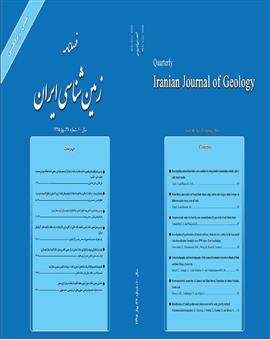لیتواستراتیگرافی و بیواستراتیگرافی سازند آسماری در یال جنوبی تاقدیس میش، تنگ گناوه (شمال گچساران)
محورهای موضوعی :فرزاد مرادی 1 , عباس صادقی 2 , حسن امیری بختیار 3
1 - دانشگاه شهید بهشتی
2 - دانشگاه شهید بهشتی
3 - شركت ملي مناطق نفت¬خيز جنوب
کلید واژه: سازند آسماری تاقدیس میش لیتوستراتیگرافی بیوستراتیگرافی الیگوسن (روپلین- شاتین) و میوسن پیشین (آکی¬, تانین - بوردیگالین).,
چکیده مقاله :
سازند آسماری در برش چینه شناسی تنگ گناوه در یال جنوبی تاقدیس میش با ستبرای 366 متر ضخامت است و بطور عمده از تناوب سنگ آهک های رسی با سنگ آهک های بسیار ضخیم، ضخیم و متوسط لایه گاه همراه با میانلایه های دولومیتی تشکیل شده است. مرز زیرین این سازند با سازند پابده تدریجی و مرز فوقانی آن با سازند گچساران بصورت هم شیب و همراه با گسستگی سنگ شناسی می باشد. در این مطالعه، توالی کربناته در برش تنگ گناوه بر مبنای جنس، تغییر ضخامت لایه ها و رنگ به سه واحد سنگ شناسی تقسیم شده است. در مطالعات زیست چینه ای 28 گونه متعلق به 41 جنس از فرامینیفرها شناسایی و 4 زون زیستی و یک زون مبهم براساس زون بندی لارسن و همکاران 2009 شناسایی و معرفی گردید. براساس مجموعه فسیلی و زون های زیستی شناسایی شده سن سازند آسماری در برش مورد مطالعه الیگوسن (روپلین - شاتین) - میوسن پیشین (آکی تانین -بوردیگالین) تعیین شد.
The Asmari Formation in the southern flank of Mish anticline (in the north of Gachsaran) with a total thickness of 366 m is mainly composed of medium to thick limestone layers. Based on lithological studies, it is mainly composed of a periodic arrangement of marly limestone with very thick, thick and medium bedded limestone layers and in some parts it consists of dolomitic layers. The lower contact of the Asmari Formation with Pabdeh Formation is gradual and its upper contact with the Gachsaran Formation is conformable with some sharp lithological changes. Based on change in thickness of layers, color and lithology, this carbonate sequence is subdivided into three lithological units. In Biostratigraphic studies, 28 species belonging to 41 genera of foraminifera were recognized. According to recognized biozone and foraminifera assemblages, 4 biozones and one undetermined zone were classified according to Laursen et al., 2009. The age of the Asmari Formation in this section is Oligocene (Rupelian-Chatian) to Early Miocene (Aquitanian-Bourdigalian).
آقانباتی، س.ع.، 1383. زمین¬شناسی ایران. سازمان زمین¬شناسی و اکتشافات معدنی کشور، 586.
مطیعی، همایون.، 1372. چینه¬شناسی زاگرس، از انتشارات طرح تدوین کتاب زمین شناسی ایران، 536.
Adams, T.D. and Bourgeois, F., 1967. Asmari biostratigraphy: Iranian Oil Operating Companies. Geological and Exploration Division, Report 1074, 34.
Adams, C.G., Gentry A.W. and Whybrow, P.J., 1983. Dating the terminal Tethyan event. Utrecht Micropal Bull., 30, 273–298.
Allahkarampour Dill, M., Seyrafian, A., and Vaziri-Moghaddam, H., 2010. The Asmari Formation, north of the Gachsaran (Dill anticline), southwest Iran: facies analysis, depositional environments and sequence stratigraphy. Carbonates Evaporites, 25,145–160
Ehrenberg S.N., Pickard, N.A.H. , Laursen, G.V., Monibi, S., Mossadegh, Z.K., Svana, T.A., Aqrawi, A.A.M., McArthur, J.M. and Thirlwall, M.F. 2007. Strontium isotope stratigraphy of the Asmari formation (Oligocene – Lower Miocene), SW Iran. Journal of Petroleum Geology. 30(2): 107 -128.
James, G.A. and Wynd, J.G., 1965. Stratigraphic nomenclature of the Iranian oil consortium agreement area. AAPG Bulletin, 40, 12, 2184–2245.
Laursen, G.V., Allan, T.L., et al., 2006. Reassessment of the age of the Asmari formation, Iran. Abstract, Forums 2006, 10–15 September 2006, Natal, Brazil.
Laursen, G.V., Monibi, S., Allan, T.L., Pickard, N.A.H., Hosseiney, A., Vincent, B., Hamon, Y., van Buchem, F.S.P., Moallemi, A., Druillion, G., 2009. The Asmari formation revisited: Changed stratigraphic allocation and new biozonation. First International Petroleum Conference & Exhibition- Shiraz.
Loeblich, A.R. and Tappan, H., 1998. Foraminiferal Genera and Their Classification, 2 Volumes. Van Nostrand Reinhold Company, New York, 970 .
Wynd, J.G., 1965. Biofacies of the Iranian oil consortium agreement area. IOOC Report, no. 1082, unpublished.


